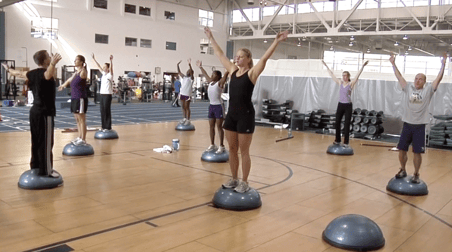 Imagine a tightrope walker, gracefully walking their path across their suspended highwire. An incredible amount of balance is required, along with stability and strength, to ensure that the performer maintains their position on the rope. Now think about balance as it applies to you and your profession or daily life. You might not even think about it, but you use balance every day. Things that you take for granted, such as walking down stairs, putting on a pair of pants, and getting out of your car require some level of balance, or else we would most likely take a tumble. Thankfully, there are exercises and routines designed to improve and train balance that transfer nicely to daily life.
Imagine a tightrope walker, gracefully walking their path across their suspended highwire. An incredible amount of balance is required, along with stability and strength, to ensure that the performer maintains their position on the rope. Now think about balance as it applies to you and your profession or daily life. You might not even think about it, but you use balance every day. Things that you take for granted, such as walking down stairs, putting on a pair of pants, and getting out of your car require some level of balance, or else we would most likely take a tumble. Thankfully, there are exercises and routines designed to improve and train balance that transfer nicely to daily life.
As with any limitation or injuries, be careful and mindful of the doctor’s recommendations. Loss of balance could be a sign that you need to be checked out by your physician. That being said, we know that exercise can be great, but we would regard and yield to the utmost safety when approaching anyone who may be at risk or falling due to balance issues.
If you have come to the conclusion that your balance needs help, there is good news for you! Like most facets of life, balance can be improved. The answer to a question as simple as, “If you want to run a 5K in 20 minutes, what would you do?” is RUN! So, if you want to get better balance, what should you do? Practice balancing. You do not have to walk a tightrope on day one, but there are many exercises and fitness tools designed to help your balance improve.
Balance Exercises
Try the following exercises and activities, and see how you do with balance, then incorporate them into your routine. Assess your balance from time to time to see how you have improved.
- Stand on an unstable surface. Using an AirEx Pad, time yourself standing on one foot. Other exercises can be done while standing on the pad such as lunges, squats, and dumbbell overhead press, utilizing the unstable surface to challenge your balancing ability. Other unstable surfaces you may use as you advance include the BOSU ball, half foam roller, and sand.
- Try unilateral exercises. Improving your leg strength through unilateral exercise is another great way to improve your balance. Some examples of these exercises include lunges, split squats, and my personal favorite, the single-leg sit and stand on a box. For this exercise, you will want to find a box that is the appropriate height (around chair height). Start from a seated position, then come to a complete stand using only one leg. Try to sit back down onto the box under complete control. This can be progressed with weights and movement patterns such as the overhead press.
- Join a group fitness class. Another way to improve balance is through group fitness classes. NIFS offers several classes that emphasize balance, such as BOSU conditioning and some that help you develop balance such as yoga and BODYCOMBAT. As stated above, the more you practice your balance, the better chance you have to improve it. In BOSU conditioning, we can progress and regress any exercise to fit your needs. The exercise doesn’t have to be impossible, but it should be challenging.
Improve Your Quality of Life
With the improvement of balance comes an overall improvement in your quality of life. Being able to trust your steps as you walk is important, as is being able to do things in life you love to do. Getting better is just a process and takes time. You must take that step forward; otherwise, you might be on shaky ground. For tips and exercises to promote balance, contact a Fitness Specialist at NIFS or join one of our many group fitness classes.
This blog was written by Thomas Livengood, NIFS Health Fitness Instructor and Personal Trainer. To read more about the other NIFS bloggers, click here.

